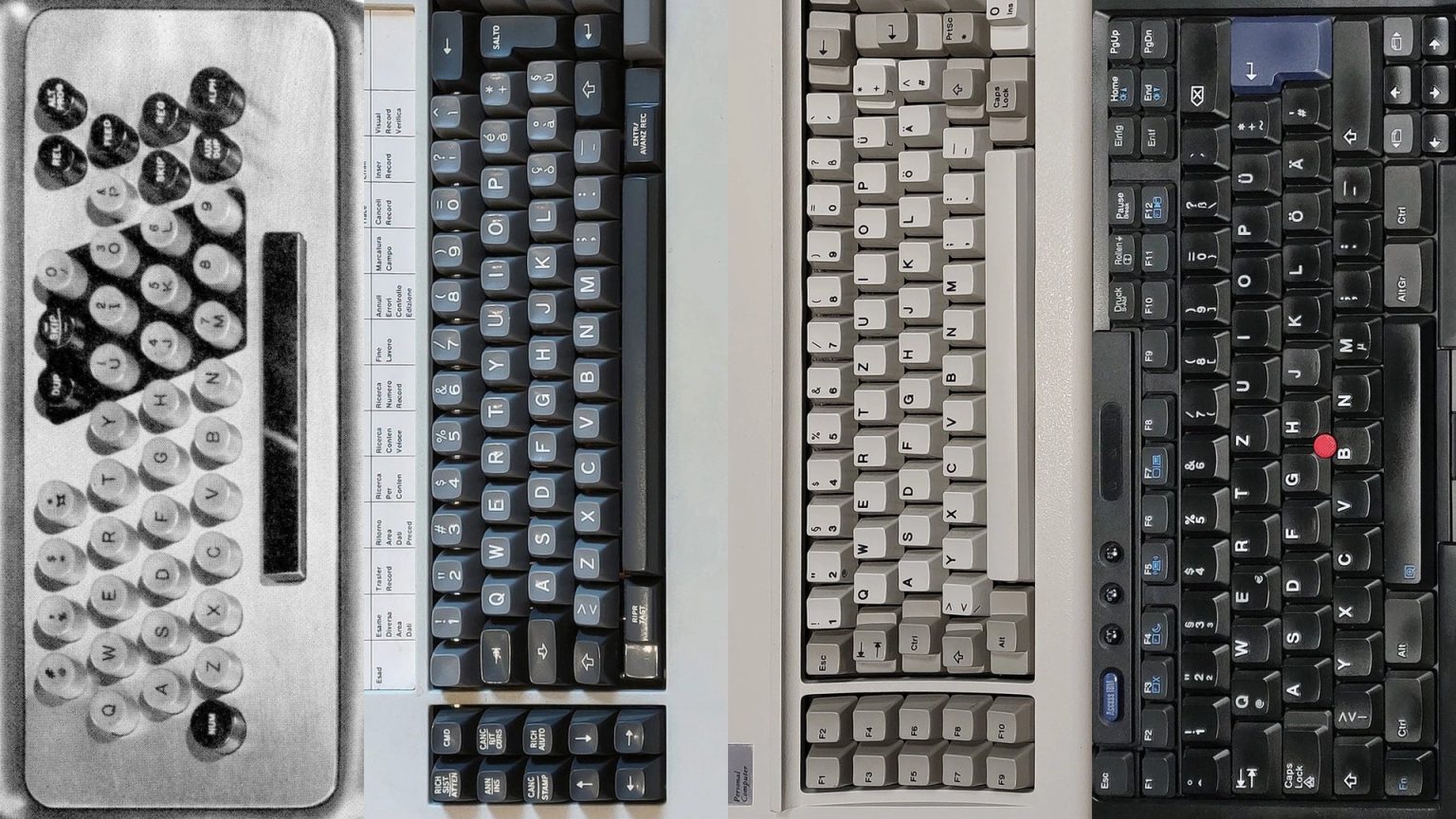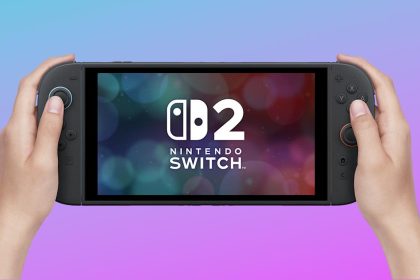This page is considered work-in-progress and should be treated as such. The design and layout of this page are subject to tweaks, and a lot of content (events) are still to be added and fleshed out. If you have any feedback or suggestions for the design and/or particular events, feel free to contact me and let me know your thoughts.
The IBM and family keyboard timeline is an illustrated overview of some of the most important events affecting IBM, Lexmark, Unicomp, Lenovo and Toshiba Global Commerce Solutions keyboards. This includes notable keyboard releases and withdrawals, corporate history like company founding, divestures and change in OEMs, and patents. Due to their relationship and impact on the keyboards around them, host devices such as personal computers, terminals, consoles and typewriters also appear throughout the timeline. 141 events have been recorded for the “show all” versions of the timeline.
1896
Herman Hollerith, a pioneer of punched card technology, founds the Tabulating Machine Company to market his inventions. Its equipment will quickly gain ground with being used for many countries’ censuses, including notably the USA’s 1900 census.
17th
May
1901
[ASK]Herman Hollerith patents the first keypunch (apparatus for perforating record-cards). This patent will be implemented as the Hollerith 001 Mechanical Card Punch, which upon IBM’s founding, became the IBM 001 Mechanical Card Punch and their first product.
16th
June
1911
Computing-Tabulating-Recording Company (CTR) is founded by Charles R. Flint upon consolidating Herman Hollerith’s The Tabulating Machine Company with Bundy Manufacturing Company, International Time Recording Company and the Computing Scale Company of America. CTR specialises in recording-keeping and measuring systems.
14th
February
1924
The Computing-Tabulating-Recording Company is renamed the International Business Machines (IBM) Corporation under the presidency of Thomas J. Watson Sr.
1933
IBM acquires Electromatic Typewriters, Inc. to gain a head start with their typewriter ambitions, gaining Electromatic’s patents, production facilities and tooling. IBM will invest $1 million in redesigning their product and improve support infrastructure for them.
1935
[1]IBM introduces its first family of electric typewriters. IBM invested heavily in the technology acquired from Electromatic, introducing the IBM Model 01 Electric Typewriter (pictured) from it. 01 would be joined by 02 through 10 within a decade’s time.
1948
[2]The IBM Model A electric typewriter family is introduced.
July
1949
[3]IBM introduces the 024 Card Punch and 026 Printing Card Punch, both BCDIC electric keypunches with a choice of a 21-key numeric keyboard or a 45-key combination keyboard (pictured). These keyboards are technically discrete and electrically separable, so they are also considered to be IBM’s first generation of keyboards under the modern sense of what a keyboard is. They use a contact-bail system for keystroke sensing called a Keyboard Permutation Unit.
1953
IBM Canada opens the 844 Don Mills Road, Toronto, Ontario plant (plant 91). This plant will go on to play a minor role in Model M production via the IBM 4680 POS Alphanumeric Keyboard, likely producing their cover set and electronics whilst the rest was made by IBM Netherlands.
1954
IBM United Kingdom opens the Greenock, Scotland plant (plant 55). Greenock became a major hub for manufacturing keyboards, personal computers, printers, terminals and typewriters destined to be sold in Europe, Middle East, and Africa (EMEA). It would go on to produce Model B, Model F and Model M keyboards and IBM ThinkPad notebook computers.
1954
[4]The IBM Model B electric typewriter family is introduced.
1956
IBM United States opens the Lexington, Kentucky plant (plant 11). This plant became associated with the IBM Information Products Division and was a known major producer of IBM typewriters and keyboards for the North American market.
2nd
September
1958
The IBM 7150 Console Typewriter & Operating Keyboard (pictured) and 7900 Inquiry Station Typewriter Keyboard are introduced. They are the earliest known forms of IBM printer-keyboards, which are considered to be IBM’s second generation of keyboards.
1959
[5]The IBM Model C electric typewriter family is introduced.
1960
IBM Netherlands opens its second Amsterdam, North Holland, the Netherlands plant (plant 58). This plant served a major manufacturer of IBM Electric Typewriter Division and its successors products such as electric typewriters, producing two million of such by 1980. In the ’80s, the plant diversified to produce electronic typewriters and keyboards including in the Model F and Model M families.
31st
July
1961
[6]IBM introduces the first Selectric electric typewriters, largely replacing the IBM Electric series. It uses whiffletree digital-to-analogue converters to translate key strokes into typed characters from its 88-character “golfball” typing element. Its styling and key feel would become a standard IBM would later try to emulate with later electronic keyboard designs. Selectric will spawn two follow-ups and specialised variants such as the Selectric Composer and various printer-keyboards.
28th
September
1963
[7]Jim Ladue and Werner Seydel patent for IBM Germany and IBM United Kingdom a “keyboard divided into two mirror-image fields”, an early design for a split-ergonomic keyboard. It is intended for typewriters or similar machines, allowing the user to position their arms and hands at more natural positions and rotation. Whilst IBM never brought this exact product to market, this patent will be cited by well-known ergonomic keyboard companies such as Kinesis and Maltron (Lillian Malt).
August
1964
IBM renames its Electric Typewriter Division to Office Products Division (OPD). This change was made to reflect how this division’s products were increasingly beyond the scope of just typewriters.
12th
October
1964
[8]IBM announces the 029 Printing Card Punch, based on the earlier 026 Printing Card Punch but enhanced for operation with the IBM System/360 mainframe family. Whilst mechanically similar, 029 now supports EBCDIC characters. Its numeric and combination (pictured) keyboards are also similar and still contact-bail based, but given a styling overhaul, connect to their host keypunch via SMS-style connectors and could have more toggle switches depending on exact configuration.
1967
[9]The IBM Model D electric typewriter family is introduced. This is IBM’s last non-Selectric typewriter.
30th
July
1969
IBM introduces its first named keyswitch design – the IBM elastic diaphragm – with the IBM 5475 Data Entry Keyboard. Elastic diaphragm encoded keyboards become IBM’s third generation of keyboards.
23rd
September
1970
[10]IBM announces the 3210 and 3215 (pictured) Console Printer-Keyboards. They are large auxiliary I/O terminals for IBM System/370 mainframes. 3210 uses a Selectric-based printer and is available as either a table-top or pedestal mounted unit, whereas 3215 uses a much faster dot-matrix printer but is only available as a table-top unit.
5th
November
1970
[11]IBM announces the 129 Card Data Recorder, the IBM System/370 era, SLT-logic successor to the 029 Printing Card Punch. The combination keyboard is now the only input device, as a numeric keyboard option was dropped. The 129 keyboard can easily be distinguished from its 129 predecessor via its program mode dial on its toggle switch panel.
6th
May
1971
[12]The IBM 3270 Information Display System debuts as a family of coaxial cabled terminals originally intended for IBM System/360 or System/370 mainframe computers. At launch, the 3270 series included the IBM 3275 and 3277 Display Stations. The first keyboards of the 3270 family were the Micro Switch SW-based 66-key (pictured) and 78-key IBM 3275 and 3277 Display Station Type A Keyboards. These “Type A” keyboards would be replaced with Model B-based “Type B” keyboards within 2 years of launch.
21st
May
1971
Richard Hunter Harris invents and patents the buckling spring (catastrophically buckling compression column switch and actuator) for IBM. This keyswitch actuator is comprised of a metal coil spring that characteristically buckles into a kink instead of compressing in a straight column, which pivots something that can be registered by some sort of sensor. The exact design is not yet solidified, but IBM will later patent two marketable derivatives in 1977 and 1983.
September
1971
[13]IBM unveils the Selectric II electric typewriter. Compared to Selectric I, a dual pitch option is added to allow the user to switch between 10-pitch mode for “correspondence” and 12-pitch mode for “business forms and reports”. Selectric IIs are also generally larger. As with its predecessor, specialised variants and printer-keyboards based on Selectric II will later be introduced.
24th
September
1971
[ASK]Richard Hunter Harris and Robert John Wolfram patent the beam spring (switch button with snap mechanism) keyswitch for IBM. The design has a leaf spring that rests at a downwards bent position, which when force is applied, snaps to an inverted position. The movement lifts a capacitive fly plate away from a pad card that can perform capacitance sensing, which is interpreted as a key press.
2nd
August
1972
[14]The IBM Model B (beam spring) keyboard family is introduced with the IBM 3158 66-key Display Console Keyboard as IBM’s fourth generation of keyboards.
April
1977
[15]The IBM System/34 midrange computer is introduced, along with the 5250 Information Display System to serve as its terminals. IBM 5250 includes the 5251 Display Station (pictured) and 5252 Dual Display Station, and the 66-key (525X-66 type) and 83-key (525X-83 type) (pictured) Model B keyboards.
May
1977
[16]The IBM Base Keyboard debuted in the form of the Model B-based 75-key and 87-key (pictured) IBM 3276 and 3278 Display Station Keyboards. The Base Keyboard was considered by IBM to be the direct predecessor to the Converged Keyboard design. The Base layout became somewhat of a standard for IBM, though perhaps competed with the IBM 5251/5252 layouts.
30th
August
1977
[ASK]Richard Hunter Harris patents the “buckling spring torsional snap actuator” for IBM, a refinement of the original 1971 buckling spring patent (US3699296A) that uses capacitance sensing via a pad card. This design is what will be brought to market as capacitive buckling springs for Model F family keyboards in a few years.
1978
IBM United States opens the Charlotte, North Carolina plant and laboratory (plant 41). This plant became associated with the IBM Information Products Division and was known to manufacturer printers. From 1993, it likely had a peripheral involvement with the Model M keyboard family as many Model M-based IBM POS keyboards such as RPOS and MPOS will have Charlotte’s plant code in their serial/ID numbers, implying at least a “location of control” relationship.
1978
IBM begins developing the IBM System/23 Datamaster, and with it, the first Model F-based keyboard assembly.
1978
[17]IBM introduces the first IBM Electronic Typewriter generation, with models 50 (pictured) and 60. They are IBM’s first electronic typewriters, granting them some internal processing capacity via electronics rather than relying on electrically-powered mechanical elements like an IBM Selectric. This generation of the design mates a Selectric-style but new 96-character “golfball” typing element with a Card Punch-like keyboard assembly with magnetic reed sensors for keystroke sensing.
August
1980
After concluding the IBM System/23 Datamaster’s development, IBM begins work on the IBM Personal Computer. This includes its keyboard, which was derived from the then-still-unreleased Model F-based IBM System/23 Datamaster Keyboard Assembly.
July
1981
The IBM Model F (capacitive buckling spring) keyboard family is introduced with the IBM 5322 System/23 Datamaster’s Keyboard Assembly as IBM’s fifth generation of keyboards.
12th
August
1981
IBM launched the original Personal Computer, along with it, the IBM Personal Computer Keyboard. Also known as the “Model F/XT”, the IBM PC Keyboard is the most common Model F keyboard variant.
May
1982
[20]IBM introduces the Computer System 9000 (CS/9000), a Motorola 68000-based laboratory computer. It comes with a variant of the Model F-based IBM Personal Computer Keyboard but with different branding, cable location and no riser feet. When the 9002 and its hybrid keyboard becomes available, 9000 and its keyboard will be renamed to 9001 Bench-Top Computer and 9001 Standard Keyboard respectively.
October
1982











